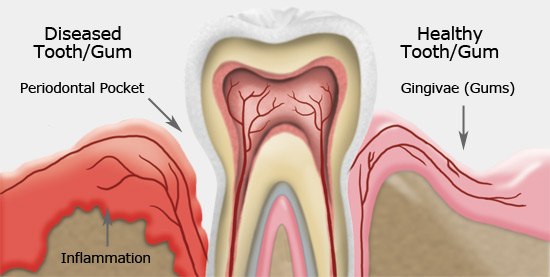Gum Treatment
Healthy Gums Keep Your Teeth in Position
Periodontitis starts as simple gingivitis, a small amount of inflammation involving the gums. As the inflammation is left untreated and progresses, continued gum destruction as well as supporting bone destruction begins to develop and spread. This spread can lead to symptoms such as easily bleeding gums, loose teeth, changes in bite, bad tastes or smells coming from the gum, and loss of attachment between gums and teeth.

What are the common signs and symptoms of periodontal disease?
Periodontal disease is often silent, meaning symptoms- particularly pain, may not appear until an advanced stage of the disease. However, you should still be on the lookout for the signs and symptoms, which include:
- Red, swollen or tender gums or other pain in your mouth
- Bleeding while brushing, flossing, or when eating certain foods
- Gums that are receding or pulling away from the teeth, causing the teeth to look longer
- Loose or separating teeth
- Pus between your gums and teeth
- Sores in your mouth
- Persistent bad breath
- A change in the way your teeth fit together when you bite
How Do Lasers Work in Dentistry?
- Atherosclerosis and heart disease
- Stroke
- Premature births
- Diabetes
- Respiratory disease
In recent years, gum disease has been linked to other health problems. There are possible connections between gum disease and:
FAQ About Periodontal Disease
Periodontal disease. You’ve been hearing a lot about it lately. Newspaper columnists write about it, television anchors discuss it and radio talk show hosts interview people who treat it. However, you still may be unclear about what this disease is and how you can tell if you have it. You are not alone.Most people don’t realize how common periodontal disease – also known as gum disease – is. In fact, three out of every four adults have some form of this disease. In most cases, it does not cause any pain and therefore goes unnoticed. However, early detection and treatment are extremely important. That’s why it will be helpful for you to know more.This brochure provides answers to some of the most commonly asked questions about gum disease and can serve as your guide to good periodontal health.
Gum disease is an infection of the gums which is caused by a film of bacteria that coats everyone’s teeth. It can occur at any age, but it is most common among adults. In the early reversible stage of gum disease, called gingivitis, gums can become red, swollen and bleed easily. When the disease progresses to the bone, which supports the teeth, it is called periodontitis and at that point can cause irreversible damage. In the advanced stages of the disease, the bone and soft tissues which support the teeth are destroyed and this may cause the teeth to become loose, fall out, or have to be removed by a dentist.
Gum disease is caused by bacteria that attach to the crown and root surfaces of the teeth. These bacteria organize to form a film called dental plaque. Because plaque is sticky and constantly forms on your teeth, it can continue to build up on the teeth and gums. If plaque is not removed through daily cleaning, it produces toxins or poisons that can irritate and inflame the gums. Eventually these toxins destroy gum tissues, causing the tissues to separate from the tooth and form deepened spaces called pockets. The pockets can then hold more bacteria, and the process can progress so that the gum tissues detach even further until the bone and other supporting tissues of the teeth are destroyed.
You may not even be aware that you have gum disease, because it often causes no pain. There are, however, a number of warning sings that may alert you. If you notice any of these sings, contact your dentist.
- Gum that bleed during tooth brushing or flossing
- Red, swollen or tender gums
- Gums that have pulled away from the teeth
- Persistent bad breath
- Pus between the teeth and gums
- Loose or separating teeth
- A change in the way your teeth fit together when you bite
- A change in the fit of partial dentures
Although gum disease occurs more frequently with advancing age, even children can be affected. For example, gingivitis is common during the teen years because of the hormonal changes that occur during puberty. Likewise, hormonal changes during pregnancy cause 30 to 60 percent of pregnant women to experience red, tender or bleeding gums. If gum disease has been present in either of these groups before hormonal changes, the symptoms may become even more severe or harder to control. Lifestyle and health problems can also increase risks. An inadequate diet and stress can interfere with your body’s ability to fight infections, including a gum infection. Smoking and tobacco use irritate the gums, increasing the risk of gum disease. Diseases such as leukemia or AIDS can increase the risk of getting gum disease because the body’s protective immune system does not function properly. Also, if you have conditions that make you more prone to infections, such as uncontrolled diabetes, gum disease can be more severe or harder to control. Be sure to tell your dentist about any conditions you have or medications that you take. Some drugs, such as oral contraceptives, antidepressants, anticonvulsants and certain antihypertensive medications, can affect your oral health.
When you go for regular dental visits, your dentist will check your mouth for any disorders, including gum disease. He or she will inspect the color and firmness of the gums and check your bite. A thorough dental examination will include using a small instrument, called a periodontal probe, to measure the depth of the space between the tooth and gum. This will determine whether you have periodontal pockets. Generally, the more severe the gum disease, the greater the depth of the pockets. Complete dental x-rays may also be taken to evaluate the bone supporting the teeth and to detect other problems not visible on clinical examination.
Except in rare cases, gum disease can be prevented by thorough daily plaque removal by brushing, cleaning between teeth with floss or inter dental cleaners, eating a balanced diet and by regularly visiting your dentist for professional cleanings. When plaque is not removed, it hardens into a rough, porous deposit called tartar. Once tartar forms, it can only be removed by a dental professional. That’s where regular dental visits come in.
Your dentist or hygienist will remove tartar, using hand instruments or an ultrasonic machine which helps vibrate the tartar off. During dental visits your dentist or hygienist can give you tips on the proper way to brush and floss and recommend a personalized oral home care program to meet your specific needs. They can also give you advice on selecting dental products that will work best for you. If you need extra help in controlling plaque, they may recommend that you rinse with an antimicrobial mouth rinse as an adjunct to your daily brushing and flossing. In choosing dental products, look for the ADA Seal of Acceptance or Recognition. The seal represents a scientific review of the product by the ADA, and is your assurance that the product has been proven safe and effective.
One key to successful treatment of gum disease is the thorough daily removal of plaque from the teeth at home. You may be instructed in the proper way to brush and floss, and if you have special needs, you may be advised to use additional aids. The early stages are usually treated by a procedure called scaling and root planning, in which your dentist and hygienist remove tartar from the teeth.
Once the bacteria and toxins that irritate the tissue are eliminated, the gum can often reattach to the tooth or shrink enough to eliminate the pocket. If gum disease is caught in the early stages, professional cleaning, combined with good oral hygiene and diet, is often enough to restore oral health.
In the more advanced stages of gum disease, a variety of treatment techniques may be necessary. These can include gum surgery to remove tartar from deep pockets and to regenerate lost gum and bone. Depending on the situation, bite adjustment, bridgework, dental implants and orthodontics may also be recommended. The recommended treatment is tailored to the individual’s particular needs and goals.“Who performs periodontal treatment?”
All dentists are taught to recognize and treat the early stages of gum disease. If your dentist thinks you should see a specialist for treatment, he or she will refer you to a periodontist. Periodontists are dentists who specialize in treating gum disease and have had additional training in this area.
You now have some of the answers to questions about periodontal disease. If you have more questions, contact your dentist. He or she can talk with you about your particular dental problems and recommend treatment that is right for you.
Your dentist or hygienist will remove tartar, using hand instruments or an ultrasonic machine which helps vibrate the tartar off. During dental visits your dentist or hygienist can give you tips on the proper way to brush and floss and recommend a personalized oral home care program to meet your specific needs. They can also give you advice on selecting dental products that will work best for you. If you need extra help in controlling plaque, they may recommend that you rinse with an antimicrobial mouth rinse as an adjunct to your daily brushing and flossing. In choosing dental products, look for the ADA Seal of Acceptance or Recognition. The seal represents a scientific review of the product by the ADA, and is your assurance that the product has been proven safe and effective.
